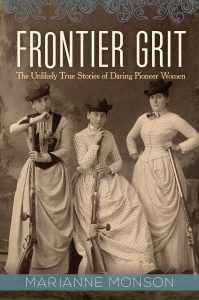Guest Post by Lana Bean
Frontier Grit by Marianne Monson
Shadow Mountain Publishing, 9/6/2016
208 pages
History
While the etymology of the word “history” doesn’t suggest that it belongs to men, it’s perhaps appropriate that it at least sounds like “his story,” because most of recorded history is written by and about men. Discovering the contributions of women generally takes more effort, searching, and often reading entire volumes, whereas men’s history is conveniently summarized in textbooks. Author Marianne Monson did her part to tackle this problem with a refreshing collection of twelve tales of 19th century women in the US who defied expectations, pulling from their own words and records as much as possible.
And it is refreshing. Not only are the stories about women, but the women represented include women of color and even one woman who lived as a man (though, as Monson notes rather coyly, “two hundred years later, it’s impossible to determine the reasons that motivated Charley’s decision to pass as a male”).
The women included in this book are:
- Nellie Cashman, an Irish-American gold rush boomer
- Aunt Clara Brown, a black woman born into slavery who gained her freedom and spent her life helping others and searching for her family
- Abigail Scott Duniway, a woman who dedicated her life to fighting for women’s suffrage in Oregon
- María Amparo Ruiz de Burton, the first Mexican-American female novelist who drew upon her own struggles of being caught between two worlds and cultures
- Luzena Stanley Wilson, a determined frontier entrepreneur
- Mother Jones, an Irish-American woman who fought tirelessly for workers’ rights
- Zitkala-Sa, a Dakota Sioux writer and activist for Native rights
- Mary Hallock Foote, a writer and illustrator who drew upon her life in mining towns
- Martha Hughes Cannon, our own rockstar of an LDS polygamist wife who became a doctor and expert on public health, made positive changes in UT, and went on to become the first female state senator
- Donaldina Cameron, a New Zealand woman of Scottish descent who moved to California and dedicated her life to rescuing girls from human trafficking
- Charley Parkhurst, a renowned stagecoach driver who lived her life as a man
- Makaopiopio, a Hawaiian native who held together her family and their culture while adopting a new home and religion
Truthfully, I have a hard time getting through books. Finding the time to stay engaged through an entire volume while children are jumping on me and/or picking fights with each other and/or spilling entire bowls of Cheerios on the floor kind of kills the momentum. This book, however, was more accessible. The nature of the book is such that each chapter can stand alone or be read in any order. The chapters are like whirlwind biographies, short enough to stay exciting and get through quickly, but far more substantial than a buzzfeed list. (Sidenote: for those reasons, this volume would make a nice coffee table book if you want to sneak attack family and friends into reading feminist literature). Monson adds her own thoughts and conclusions at the end of each chapter, but the stories speak for themselves well enough that the conclusions really just serve as extra food for thought.
For me, the most moving chapter was the one recounting the life of Donaldina Cameron, who rescued girls from the sex trade. To say that the lives of those children were heartbreaking would be a gross understatement. As soon as I finished that chapter, I picked up my computer and began looking for resources on human trafficking to see what I could do to help, assuming I would find that most trafficking was on a smaller scale if local, or in sweatshops and faraway places. To my disgust, I found that there were a dozen brothels within about 5 miles of my house, financed by wealthy people in the area, with trafficked Korean women forced into prostitution. I spent the next few hours studying resources on human trafficking so that I can do my part to stop it.
Ultimately, a strongly motivated reaction is what Monson wants. At the close of her introduction, she hopes these stories serve as “inspiration for modern-day efforts to venture into new and unknown paths…and harness a vision of how we might rebuild this tumultuous world into something better, truer, and stronger for generations yet to come.” Frontier Grit is certainly worth a read, and the tenacity of the women represented in the book is worth emulating.






Recent Comments